Terra Cotta Casting #2
|
Code # L4170B |
Batch # -2 |
| Materials | Amt | Units |
|---|---|---|
| Redart | 90.000 | GM |
| KT #1-4 Ball Clay | 10.000 | GM |
| Additions | Units | |
|---|---|---|
| Water | 44.000 | GM |
| *Darvan #7 | 0.960 | GM |
Total:144.96 (R)
Notes
The original L4170 recvipe was 80:20 Redart:Ball Clay. This change was done to speed up casting time (since ball clay slows it down). However casting rate is still pretty slow. But other qualities are still good.
We are testing a variety of glazes and underglazes on this with good success. We have found that typical low temperature glazes are working well at cone 06-04 (of course, 04 will give ware of better strength). At cone 04 this has a little less thermal expansion than Plainsman L215 plastic terra cotta, so compared to it glazes are less likely to shiver, more likely to craze).
This is producing a stoneware starting around cone 02. To make a plastic version we are adding 3% bentonite. It is more thermally stable than typical terra cotta bodies. It does not bloat on over-firing and fires to porcelain density by cone 4. Most terra cottas turn an ugly brown when fired toward maturity, but with this one the color gets even richer. By cone 5 it is continuing to densify (reaching zero porosity).
Pictures
L4170B bars fired cone 06-8 (bottom to top)

No sign of bloating even at cone 6. But it is clearly melting by cone 8. The front-sides of the cone 5-7 bars have some solubles salts that are glossing edges.
G3879 transparent at cone 1 on L4170 terra cotta

This combination qualifies as a stoneware, the body has less that 2% porosity at this temperature.
Cast L4170B pieces fired at cone 04, 2
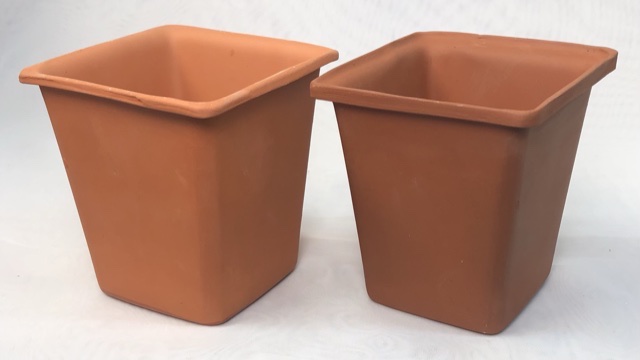
Very dense and strong at cone 2, it’s fired surface is almost velvety, very pleasant to touch.
L4170B terra cotta at cone 02 with G1916Q

Very strong piece, no sign of crazing a week later. It appears as pieces are fired to cone 02 or more, crazing ceases to be an issue.
G1916Q on L4170 cast pieces

G1916Q on L4170 cone 04

Thin application is clearly the way to get the best transparent. The glaze eventually craze where application is thicker.
Handles are L215 P6877 pugged clay

Handles are L215 P6877 pugged clay attached to mugs with the L4170B slip which acts like glue, a minimal amount required to attach handles. No cracking evident anywhere around handles.
L4170B Terra cotta fired at cone 3 with G1916Q

The glaze is clouding and micro-bubbling but the body is showing no signs of bloating.
At cone 4 Cloudiness is worse that cone 3 and it is over fired.
L4170B with G1916QL, G3879V, G1916Q

G1916QL and G3879V at cone 04 had not crazed after months.
G1916Q at cone 1 has not crazed either, even though it was thick.
L4410G, L4170B cone 2 spectrum low fire glazes

Spectrum low temperature 753 yellow, 754 orange glazes are bubbling at cone 2.
Cone 03 with Spectrum 753, 754 glazes

They are working well. No crazing after months.
L3685Z5 engobe at cone 03 on L4170B

Incredibly white, better than the Amaco Velvet white underglaze.
L3685Z5 is the same as L3685Z2 but it adds 3% Ferro Frit 3110 to get a little more fired hardness. L3685Z8 has 2% Frit 3110.
Testdata
SHAB - Shrinkage/Absorption
| DLEN | FLEN | FWT | BWT | CONE | DSHR | FSHR | ABS | |
| 12 | 94.33 | 88.51 | bloating | 8.0 | 5.7% | 6.2% | ||
| 10 | 94.23 | 87.97 | 42.47 | 42.48 | 7.0 | 5.8% | 6.6% | 0.0% |
| 9 | 94.35 | 87.66 | 41.24 | 41.24 | 6.0 | 5.7% | 7.1% | 0.0% |
| 8 | 94.34 | 87.7 | 41.14 | 41.16 | 5.0 | 5.7% | 7.0% | 0.0% |
| 1 | 94.35 | 88.08 | 39.13 | 39.46 | 4.0 | 5.7% | 6.6% | 0.8% |
| 2 | 94.59 | 88.71 | 40.08 | 41.11 | 3.0 | 5.4% | 6.2% | 2.6% |
| 3 | 94.63 | 89.15 | 38.97 | 40.3 | 2.0 | 5.4% | 5.8% | 3.4% |
| 4 | 94.33 | 89.19 | 39.69 | 41.42 | 1.0 | 5.7% | 5.4% | 4.4% |
| 5 | 94.26 | 89.44 | 39.28 | 41.23 | -1.0 | 5.7% | 5.1% | 5.0% |
| 6 | 94.2 | 90.18 | 39.69 | 42.23 | -2.0 | 5.8% | 4.3% | 6.4% |
| 11 | 94.15 | 90.72 | 42.08 | 45.12 | -3.0 | 5.8% | 3.6% | 7.2% |
| 7 | 94.33 | 92.21 | 39.94 | 44.21 | -4.0 | 5.7% | 2.2% | 10.7% |
| 13 | 94.42 | 93.89 | 40.2 | 45.6 | -6.0 | 5.6% | 0.6% | 13.4% |
XML (to paste into Insight)
<?xml version="1.0"?> <recipes version="1.0" encoding="UTF-8"> <recipe name="Terra Cotta Casting #2" id="189412" key="w1kbEB5L" date="2024-05-08" codenum="L4170B"> <recipelines> <recipeline material="Redart" amount="90.000" tolerance="" unitabbr="GM"/> <recipeline material="KT #1-4 Ball Clay" amount="10.000" tolerance="" unitabbr="GM"/> <recipeline material="Water" amount="44.000" unitabbr="GM" added="true"/> <recipeline material="Darvan #7" amount="0.960" unitabbr="GM" added="true"/> </recipelines> </recipe> </recipes>
Born: 2019-03-20, Modified: 2024-05-08 20:17:09
Terra Cotta: Plastic
|
Code # L4170BP |
| Materials | Amt |
|---|---|
| Redart | 90.000 |
| OM#4 Ball Clay | 10.000 |
| Additions | |
|---|---|
| Bentonite | 3.000 |
Total:103.00
Notes
Testing this with L3685Z5 engobe (it has 20% zircopax for super whiteness).
Pictures
L4170BP vs Plainsman Snow
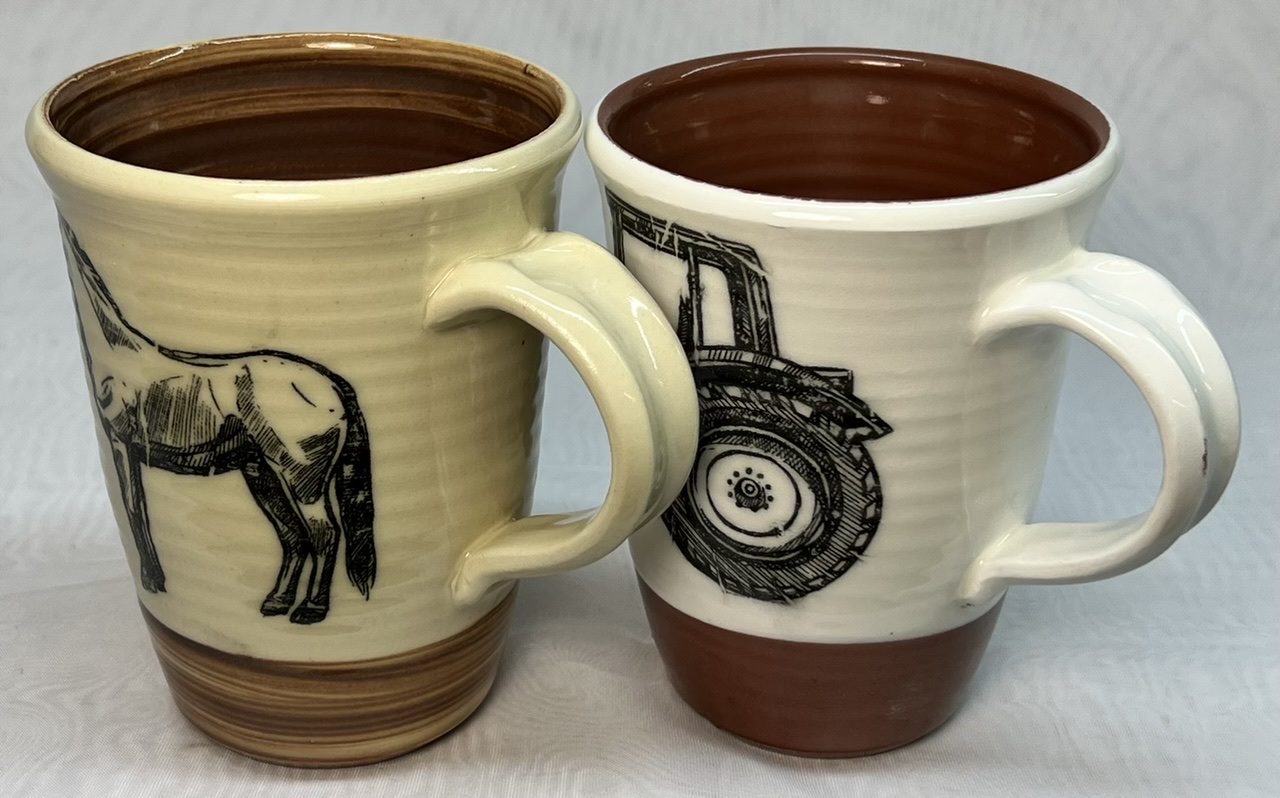
It is better to make the mug from the white Snow body and apply a terra cotta engobe inside and outer bottom or is it better to make it from a terra cotta and apply a white engobe on the upper outside? The white engobe is much whiter. The terra cotta is much stronger.
XML (to paste into Insight)
<?xml version="1.0"?> <recipes version="1.0" encoding="UTF-8"> <recipe name="Terra Cotta: Plastic" id="217426" key="MhJE2sdG" date="2022-08-24" codenum="L4170BP"> <recipelines> <recipeline material="Redart" amount="90.000" tolerance=""/> <recipeline material="OM#4 Ball Clay" amount="10.000" tolerance=""/> <recipeline material="Bentonite" amount="3.000" added="true"/> </recipelines> </recipe> </recipes>
Born: 2019-03-20, Modified: 2022-08-24 13:08:36
Terra Cotta: Plastic with silica sand
|
Code # L4170BS |
| Materials | Amt |
|---|---|
| Redart | 90.000 |
| KT #1-4 Ball Clay | 10.000 |
| Additions | |
|---|---|
| F-75 silica sand | 5.000 |
| Bentonite | 3.000 |
Total:108.00
Notes
White slip is L3684Z5.
Added 112g F-75 to 2.8kg of pugged.
Was not able to feel it on throwing but the clay was a little less slick.
Pictures
Right mug is L4170B with 10% silica sand
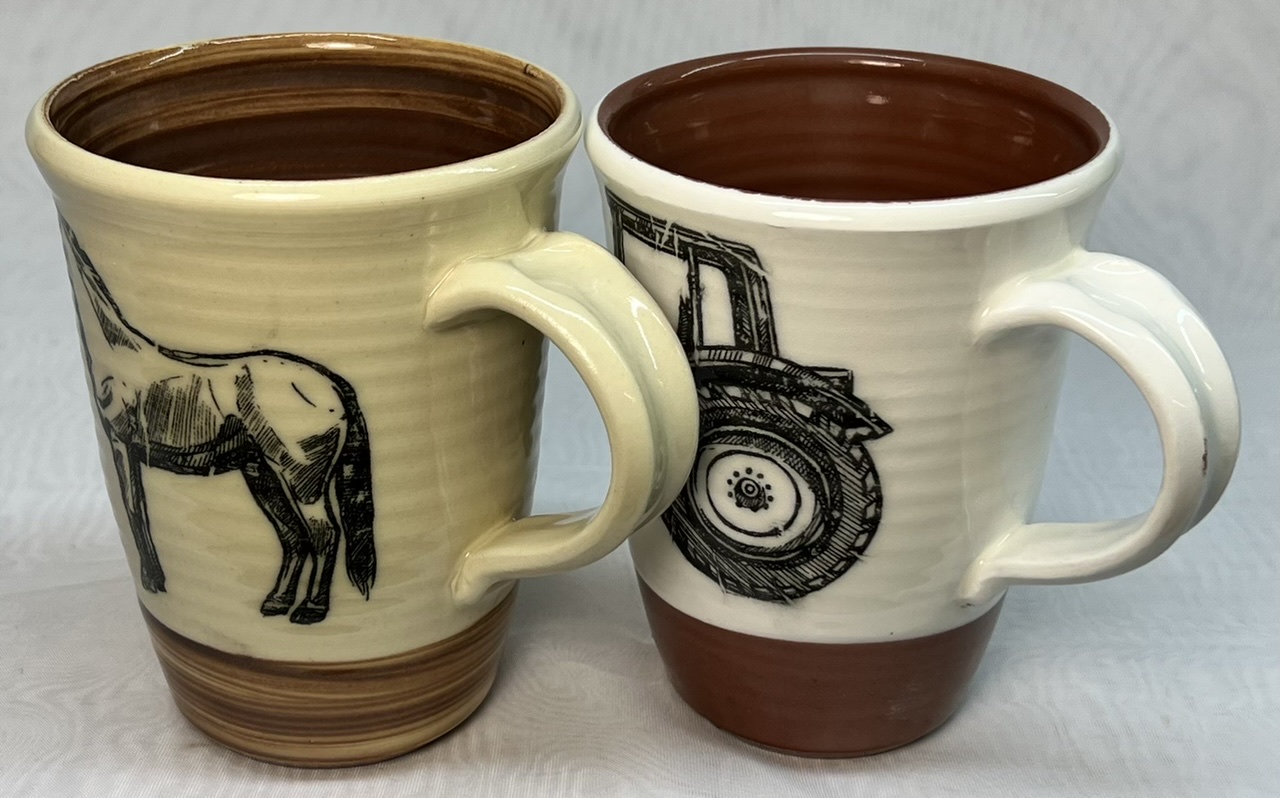
Glaze is G1916Q at cone 04. It has been applied thin enough that there is very little clouding.
Left mug is Snow clay with Amaco V-303 Terra Cotta underglaze (inside and base). Clearly it is not nearly was white as the engobe on the L4170B.
Almost crystal clear on both, slight clouding in foot right.
L4170BS Terra Cotta: mug bases
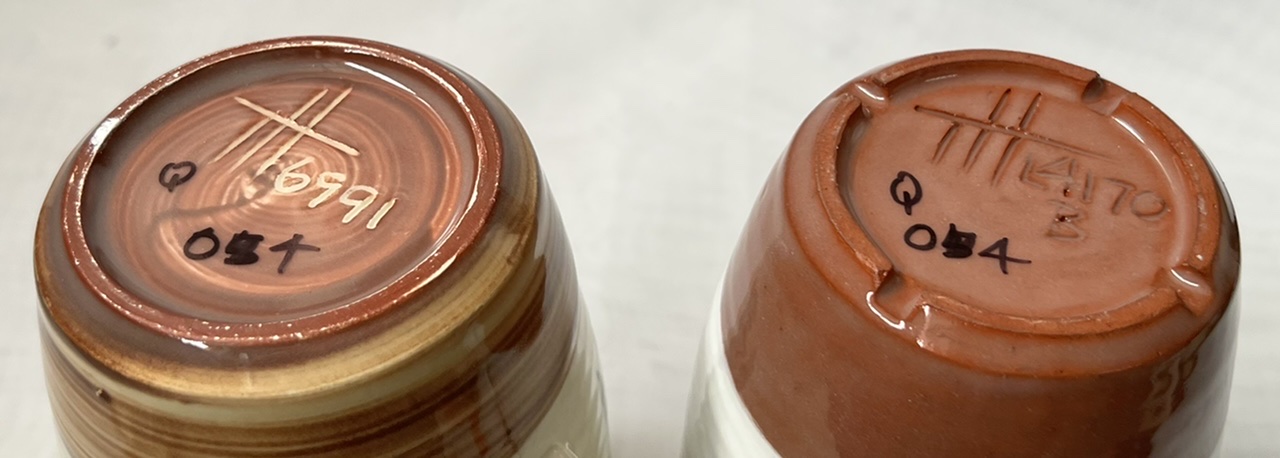
With Spectrum 700 at cone 05
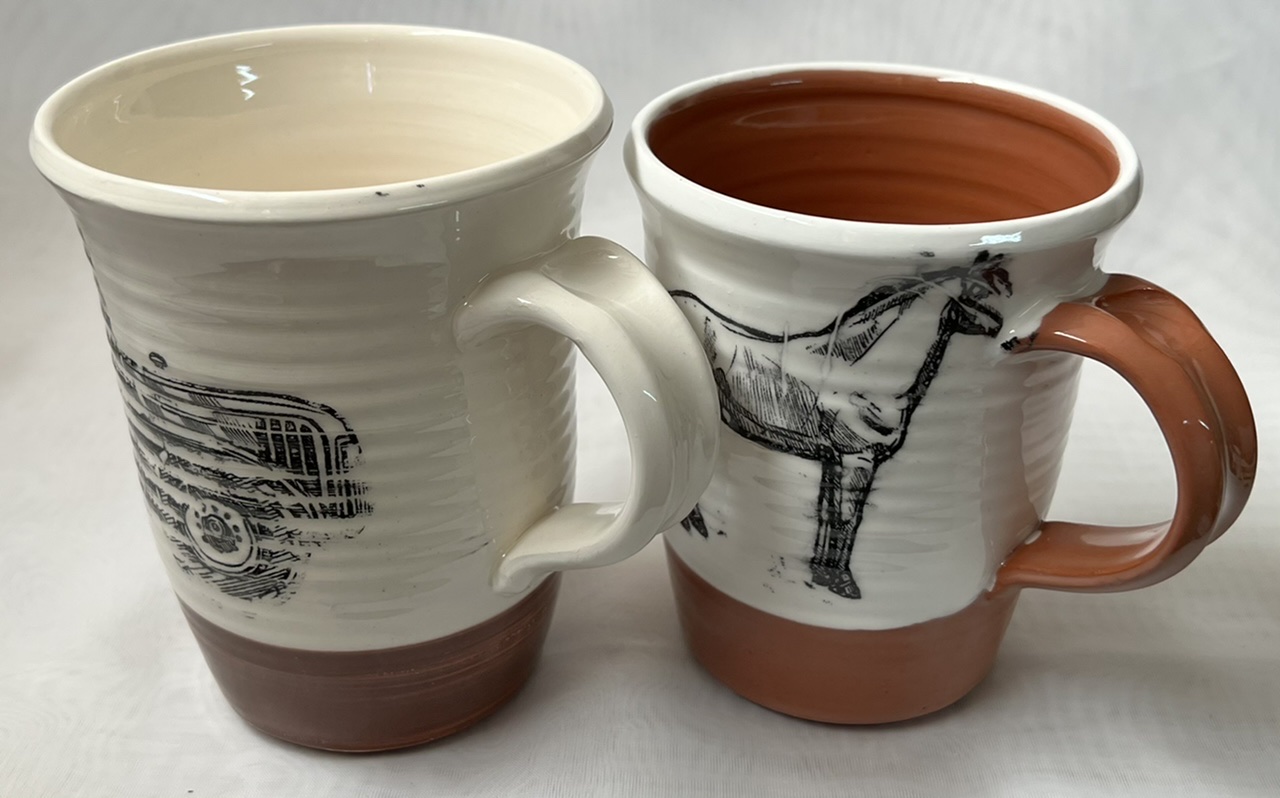
The Snow (left) has the best coverage of all so far, an exceptional glazed surface. The L4170B with 700 is close behind.
L4170BS Terra Cotta: mug bases
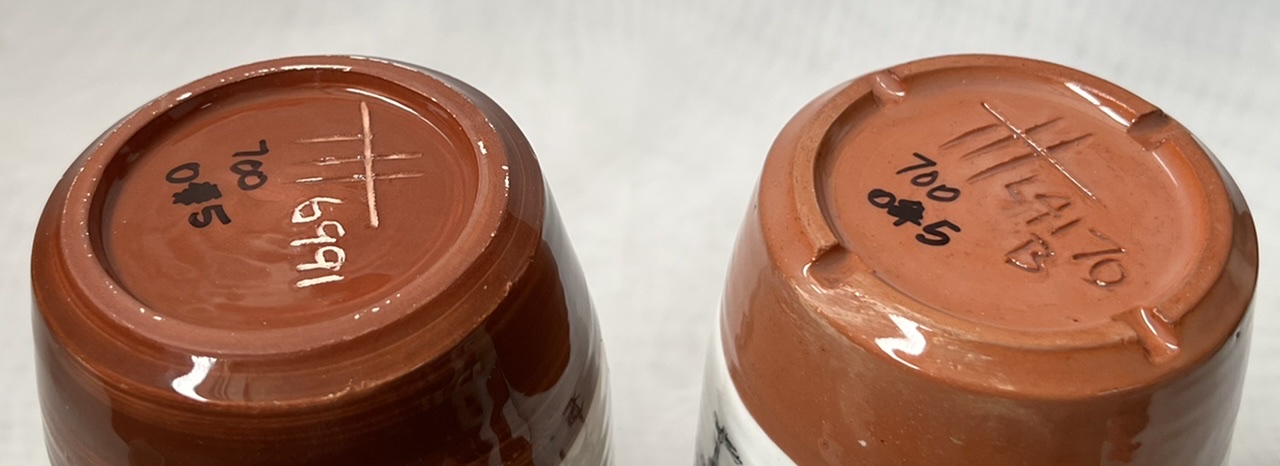
With G1916Q3 at cone 04
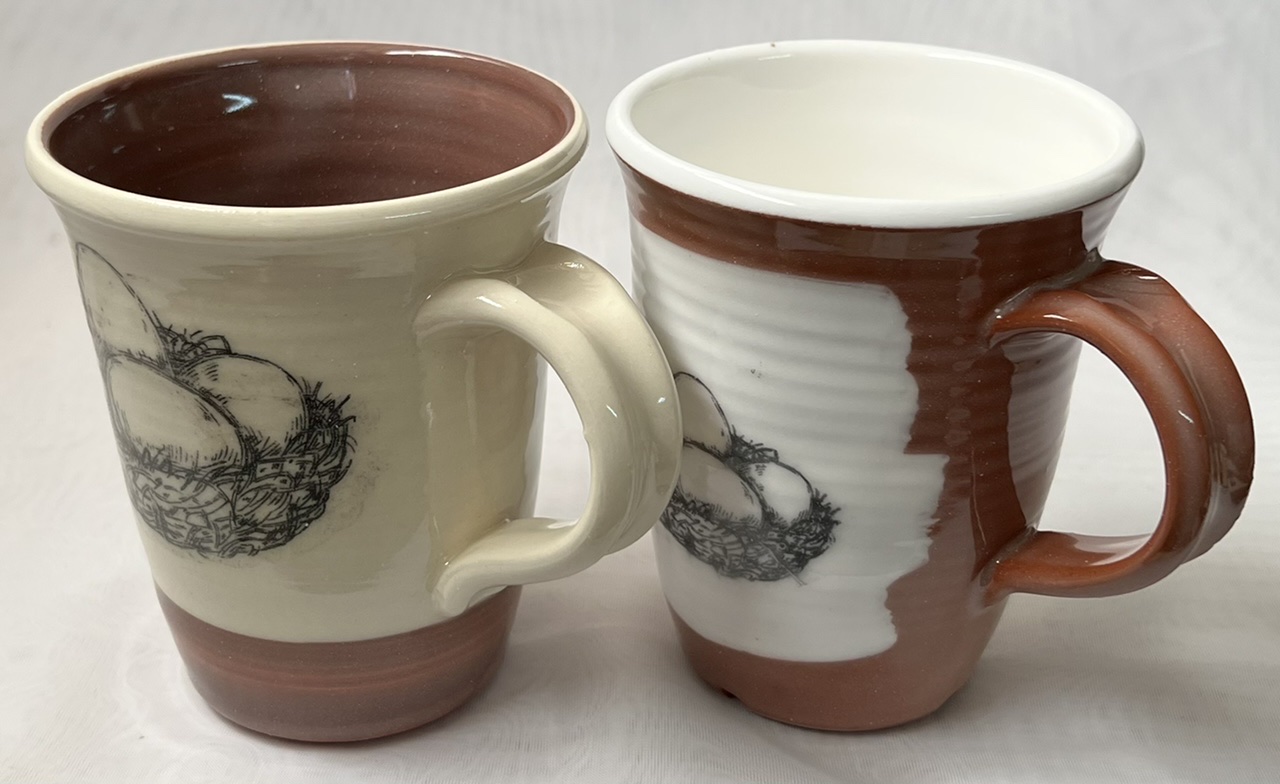
On too thick, poorly mixed. But shows good promise.
L4170BS Terra Cotta: mug bases with clear glaze

With G3879C brushed on - Cone 04
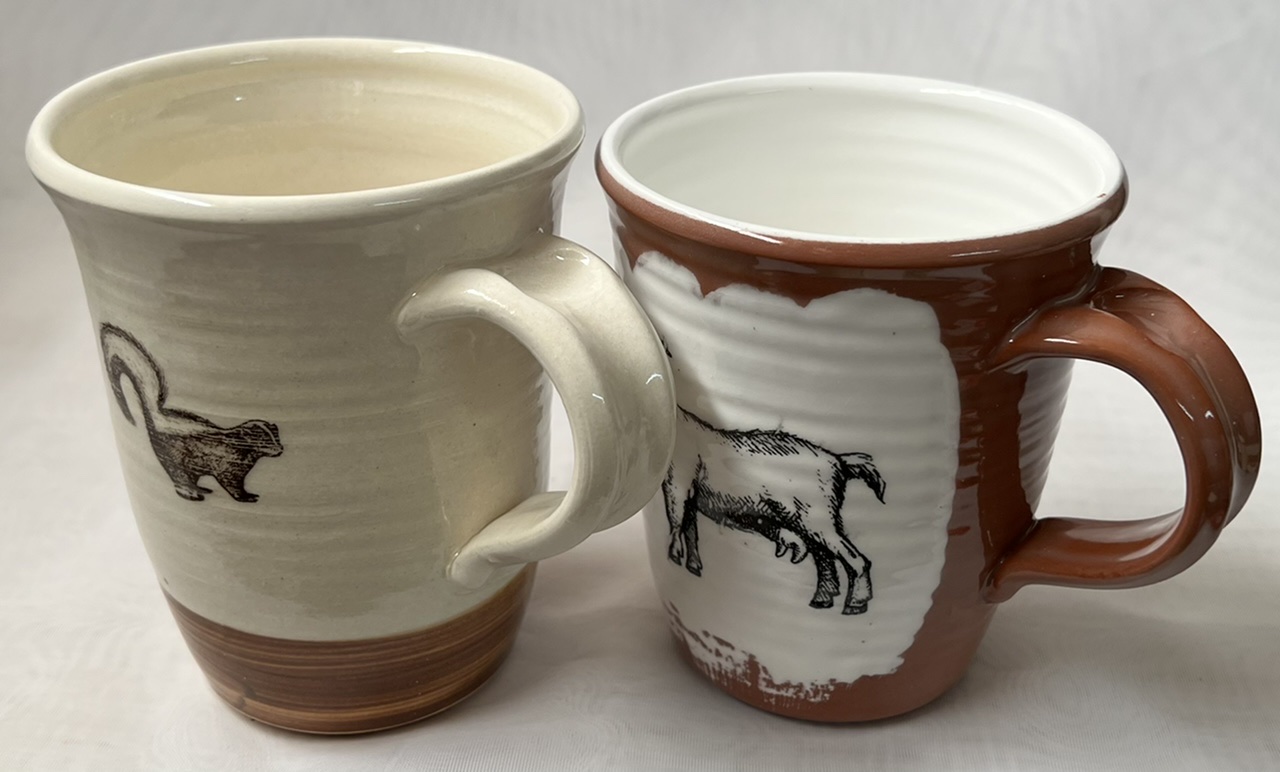
Application on Snow is too thin. On L4170B it is just right (was 3 coats). Slight clouding in some places.
The left mug is Snow with Amaco V-303 Terra Cotta slip on the bottom.
The left mug is Snow with Amaco V-3

The left mug is Snow with Amaco V-303 Terra Cotta slip on the bottom.
L4170BS Terra Cotta: fired bars
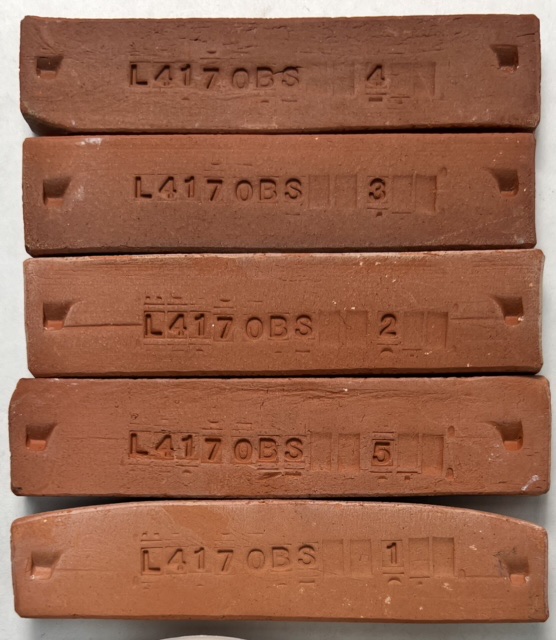
Testdata
SHAB - Shrinkage/Absorption
| DLEN | FLEN | FWT | CONE | DSHR | FSHR | ABS | |
| 4 | 92.3 | 88.6 | 38.61 | 2.0 | 7.7% | 4.0% | |
| 3 | 92.5 | 87.1 | 37.84 | 1.0 | 7.5% | 5.8% | |
| 2 | 92.5 | 87.9 | 39.51 | -2.0 | 7.5% | 5.0% | |
| 5 | 93.2 | 91.69 | 38.47 | -4.0 | 6.8% | 1.6% | |
| 1 | 93.1 | 91.4 | 35.4 | -6.3 | 6.9% | 1.8% |
XML (to paste into Insight)
<?xml version="1.0"?> <recipes version="1.0" encoding="UTF-8"> <recipe name="Terra Cotta: Plastic with silica sand" id="217744" key="jrzH2MQy" date="2022-09-06" codenum="L4170BS"> <recipelines> <recipeline material="Redart" amount="90.000" tolerance=""/> <recipeline material="KT #1-4 Ball Clay" amount="10.000" tolerance=""/> <recipeline material="F-75 silica sand" amount="5.000" added="true"/> <recipeline material="Bentonite" amount="3.000" added="true"/> </recipelines> </recipe> </recipes>
Born: 2019-03-20, Modified: 2022-09-06 11:09:31
Cone 04 Plastic Stoneware
|
Code # L4170C |
| Materials | Amt |
|---|---|
| Redart | 75.000 |
| KT #1-4 Ball Clay | 20.000 |
| Ferro Frit 3110 | 5.000 |
| Additions | |
|---|---|
| Bentonite | 3.000 |
Total:103.00
Notes
Only a little frit is needed to convert L4170B into a stoneware at cone 02 (and makes it much stronger at cone 04). This should also fit glazes better since this frit has high thermal expansion.
Density has increased markedly with the frit addition. For porosity, note the reductions (lower numbers mean higher density):
Cone 06 - 13.4% to 9.5%
Cone 04 - 10.5% to 5.7%
Cone 02 - 6.4% to 2.0%
Pictures
L4170C fired bars
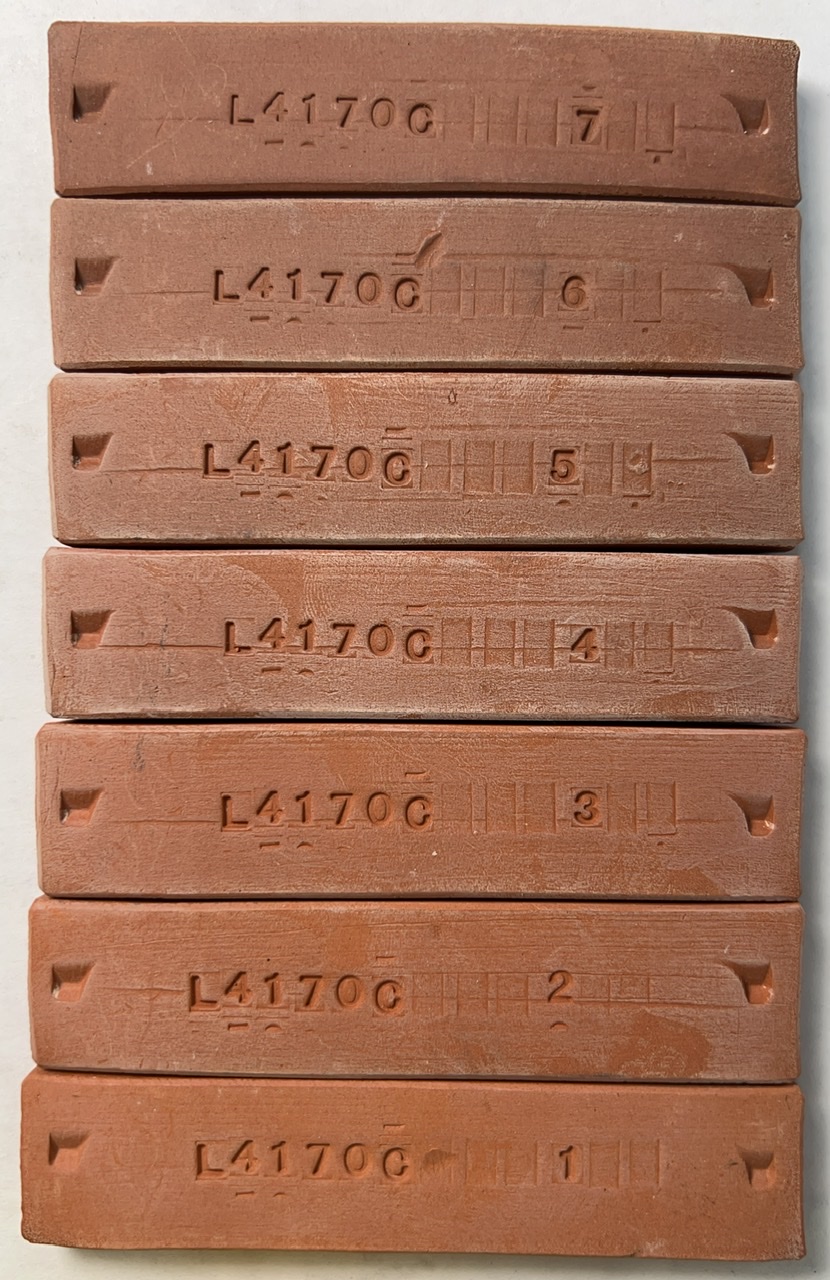
Some soluble salts are appearing on the surface so this needs a little barium carbonate (e.g. 0.1%).
Testdata
SHAB - Shrinkage/Absorption
| DLEN | FLEN | FWT | BWT | CONE | DSHR | FSHR | ABS | |
| 7 | 93.4 | 87.54 | 40.45 | 40.60 | 1.0 | 6.6% | 6.3% | 0.4% |
| 6 | 93.48 | 87.7 | 39.33 | 39.91 | -1.0 | 6.5% | 6.2% | 1.5% |
| 5 | 93.49 | 88.07 | 38.96 | 39.73 | -2.0 | 6.5% | 5.8% | 2.0% |
| 4 | 93.53 | 88.55 | 38.19 | 39.47 | -3.0 | 6.5% | 5.3% | 3.4% |
| 3 | 93.58 | 89.66 | 38.7 | 40.9 | -4.0 | 6.4% | 4.2% | 5.7% |
| 2 | 93.59 | 90.67 | 39.17 | 41.96 | -5.0 | 6.4% | 3.1% | 7.1% |
| 1 | 93.65 | 91.39 | 38.03 | 41.65 | -6.0 | 6.3% | 2.4% | 9.5% |
APD - Apparent Density
| LEN | WID | HT | WT | DENS | |
| 2 | 44.91 | 21.8 | 8.3 | 17.23 | 2.12 |
XML (to paste into Insight)
<?xml version="1.0"?> <recipes version="1.0" encoding="UTF-8"> <recipe name="Cone 04 Plastic Stoneware" id="215285" key="QGGWiW4q" date="2022-09-21" codenum="L4170C"> <recipelines> <recipeline material="Redart" amount="75.000" tolerance=""/> <recipeline material="KT #1-4 Ball Clay" amount="20.000" tolerance=""/> <recipeline material="Ferro Frit 3110" amount="5.000" tolerance=""/> <recipeline material="Bentonite" amount="3.000" added="true"/> </recipelines> </recipe> </recipes>
Born: 2019-03-20, Modified: 2022-09-21 17:25:25
